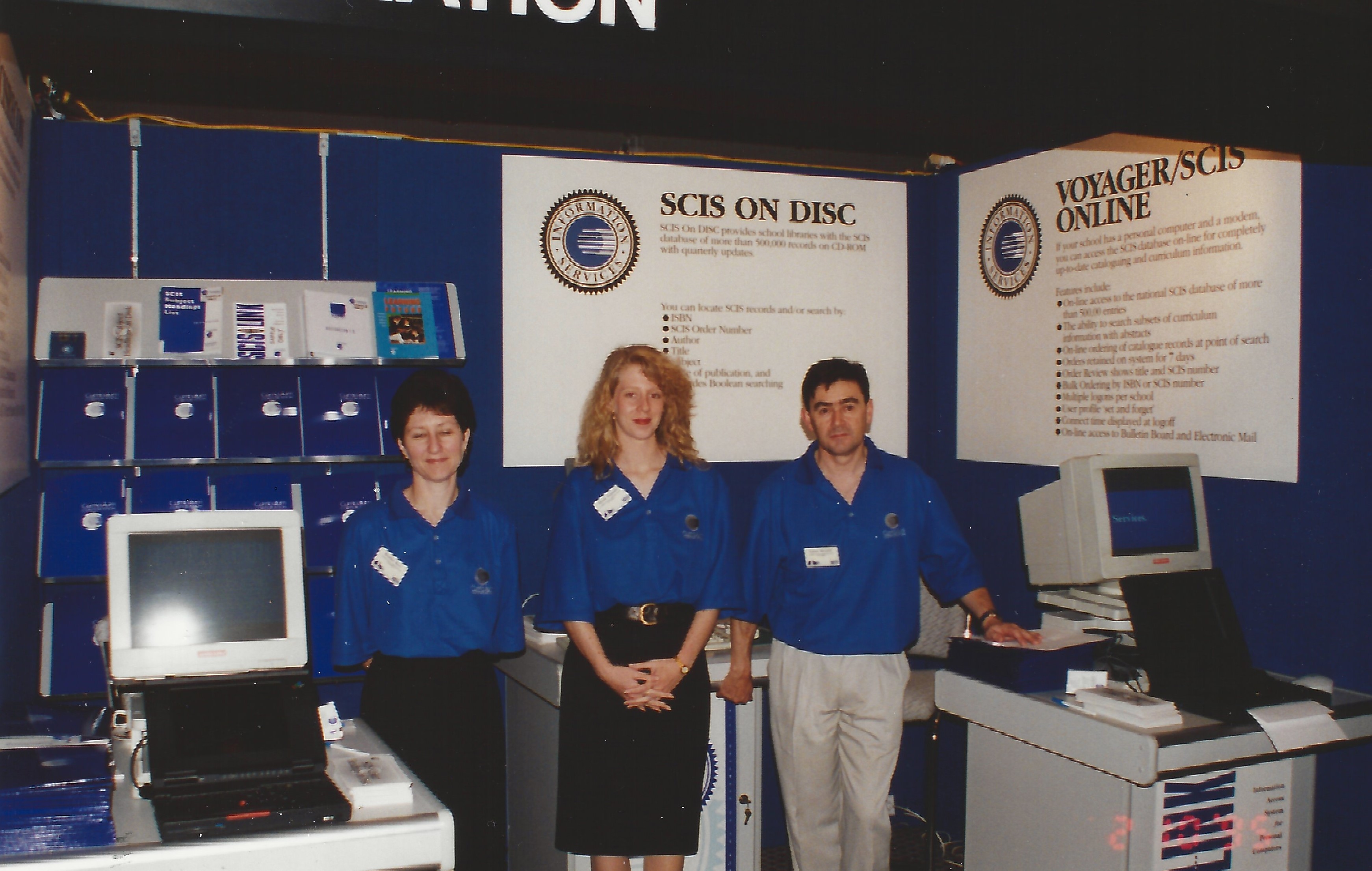Issue 120
Term 1 2022
School libraries then and now - in the digital environment
Lance Deveson, one of the founders of Connections, looks back at how school libraries have changed over the last 30 years and ponders what the next 30 years might look like.

Lance and colleagues posing at a SCIS stand at an expo in the early 1990s
Once again I feel very privileged to have been invited by the Connections staff to write an opinion piece. This time it is on how school libraries have changed over the past 30 years and how they might look in the rapidly evolving digital environment. How time flies when you’re having fun!
Thirty years ago when Connections was created, most schools had at least one trained teacher librarian, and these dedicated staff introduced valuable literature to their students, taught information skills, catalogued their own collections or ordered cards from their state library branches, and had collections that also supported their school curriculums. Computers were starting to weave their way into schools and that movement assisted the move from card catalogues to online access, and Connections was available only on paper!
Technology, leadership and change
With the access to computers and the move by SCIS to provide an automated delivery system, school libraries jumped at the new technology. In many cases, they led in the use of new technology in their schools. Teacher librarians used this new technology to create automated catalogues and find new ways to seek information for their students. This has continued through the 2000s to the present. School libraries still often lead in their use of technology, with their multi-formatted collections and genrefied collections supporting school curriculum outcomes.
Accessibility and credibility
When thinking about school libraries in the digital world of today, school libraries and teacher librarians still have a vital place to play in supporting their school curriculum and student learning with resources both physical and online. The library catalogue in most schools is now an online resource and, as such, controlled access can be provided to students outside of the school and school hours – a great development. Taking this idea further, it is interesting to see that a number of schools have now employed, or are employing, online media expertise or graphic designers to assist in making their resources attractive and available to school communities using the social media platforms – another way of making access to resources easier for school communities. Undertaken with appropriate controls in place, this is yet another way of making information available in today’s digital world.
With the advent of social media and the growth of ‘fake news’, libraries and teacher librarians also have a role and a duty to provide access to real, credible data and show students how to access, recognise and show evidence of its credibility.
The library: a supportive environment
While I was researching this article, colleagues pointed me to an interesting paper by Dr Margaret Merga, formerly Senior Lecturer in the School of Education at Edith Cowan University in Western Australia. In June 2021, her paper ‘Libraries as wellbeing supportive spaces in contemporary schools’ was published in the Journal of Library Administration. In this research, Margaret and colleagues looked at how students used the library and how often it became a safe haven for many students and their wellbeing – especially during this past two years of the COVID-19 pandemic. (It did take me back to my early days in school libraries where I often had students volunteering to be library monitors to escape the schoolyard battles of the time.)
Margaret Merga’s study centres on students in years 4 to 9 at schools in Western Australia, but its research results are very relevant to other states, territories and education systems. Library managers and students were interviewed and completed a survey on their usage of the library both in class time and at other times. It was felt that library managers ‘would be well-situated to comment on the workings of the library, and specifically, the role of the library in fostering student wellbeing’.
Outcomes of the research indicated that the library was a safe space that encouraged belonging, and many students visited it out of class times to read, relax, play quiet games, ‘chill out’ and feel safe.
The school library encouraged:
- belonging
- books and reading - still a major reason for visiting the library
- relaxing and recharging
- staff – trained teacher librarians – seen as friendly, caring staff, someone to whom students could talk
- furnishings - creating a safe and caring environment
- decorations - encourages and providing display of student work
- a lively and creative space
- quietude - students still liked to have space within the library for quiet reading and reflection with peers.
The research concludes that the school library has a vital role to play in student wellbeing in today’s digital world. I encourage teacher librarians and school leaders to read this article.
Change and constancy
Thinking over the past 30 years of Connections, and reading the many great articles about developments that have progressed the spread of information and supported school curriculum outcomes, it is clear to me that we have come a long way since we encouraged schools to log on to SCICLINK to download their records or use the SCISROM to copy the data.
It is great to see that one important constant, which I hope will still be around in another 30 years, is the trained teacher librarian in many school libraries. The trained teacher librarian who can skilfully curate a multi-format, multi-access and multi-platform collection that supports the curriculum, share their love of reading with students, and create a welcoming, stimulating and caring environment. This person, to me, is still the glue that holds the school library and all its elements together – even more necessary in today’s digital environment.
Finally, I’m very proud to again be a part of Connections as it enters its 30th year. I am also pleased that the idea of a newsletter targeted to school librarians, which I sold to Dr David Francis (founding director of Curriculum Corporation, now Education Services Australia) was enthusiastically supported and still remains in this digital age.
Acknowledgments
In writing this article to celebrate 30 years of Connections, and now being happily retired, I sought advice from two very experienced colleagues and friends.
The first is Emeritus Professor Dr Mike Eisenberg, formerly of the Information School, University of Washington, Seattle. Now also retired, he has long been a leader in advancing school librarianship in the USA and beyond. Mike and I have been friends since I invited him to come to Perth in 1993 to deliver the SCIS Oration at the Australian School Library Association (ASLA) Conference. Mike is still active in his retirement, advancing school librarianship with his podcast Libraries lead in the New Normal.
The second friend and colleague is Dr Lyn Hay, Vice President of the NSW School Library Association (SLANSW), and formerly a lecturer in the School of Information Studies, Charles Sturt University, Wagga Wagga. Like Mike, Lyn and I have been long-time friends since I was involved in the School Library Association of Victoria (SLAV), and we did some guest-lecturing about SCIS at Charles Sturt in the 1990s. Lyn is still very active in school librarianship and runs her own consultancy business, Leading Learning Institute, assisting schools and teacher librarians with their programs.
References
Merga, M. K. (2021). Libraries as wellbeing supportive spaces in contemporary schools. Journal of Library Administration, 61(6), 659–675. doi.org/10.1080/01930826.2021.1 947056
